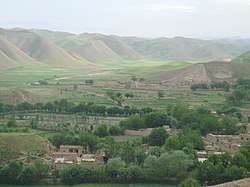Badghis Province
Badghis
بادغیس | |
|---|---|
Province of Afghanistan | |
 A village in Badghis | |
| Motto: "Home of Bala Murghab" | |
 Location within Afghanistan | |
 Districts prior to 2005 realignment | |
| Country | |
| Provincial seat | Qala i Naw |
| Districts | |
| Government | |
| • Governor | Dilbar Jan Arman Shinwari |
| Area | |
| • Total | 20,591 km2 (7,950 sq mi) |
| • Water | 0 km2 (0 sq mi) |
| Population | |
| • Total | 499,393 |
| • Density | 20.9/km2 (54/sq mi) |
| Ethnic groups | |
| • | Tajiks |
| • | Pashtuns |
| • | Uzbeks |
| • | Turkmen |
| Languages | |
| • | Dari Persian Pashto Turkmen |
| ISO 3166-2 code | AF-BDG |
Bādghīs (Persian/Pashto: بادغیس Lap of Wind) is one of the thirty-four provinces of Afghanistan. It is located in northwestern Afghanistan, between the Murghab and Hari rivers, extending as far northward as the edge of the desert of Sarakhs. It includes the Chul formations through which the Russo-Afghan boundary runs.[2] The province was carved out of portions of Herat Province and Meymaneh Province in 1964 and has a total area of 20,591 km2.[3] Its name is from Persian word Bādkhīz (بادخیز) meaning "where the winds arise" or "home of the winds".
History
The name "Badghis" is from the Persian word Bādghezz (باد غیس) meaning "lap of wind" or "home of the winds". The province was one of the last captured by the Taliban in their military offensive before the American invasion in 2001. Even after their official takeover of the province, the largely Tajik population of the province never welcomed the Pashtun Taliban. The province was quickly retaken by Northern Alliance forces as the United States initiated hostilities, which was followed by a brutal cleansing of the Pashtun minority in the province.
Various influential warlords have traded control of the province in recent years, including: Abdul Malik, Rashid Dostum, Juma Khan and Ismail Khan. During the fight against the Taliban, the Northern Alliance commanders received military aid from Shia Iran, fearful of the Sunni Taliban. In one notable incident, Malik temporarily switched his allegiances from Dostum, allowing the Taliban to gain control of the province.
Geography
Badghis Province is located in the isolated hills of northwestern Afghanistan and shares its borders with Herat, Ghor, and Faryab provinces as well as Turkmenistan. The province is dominated by the Murghab River in the north and the Hari-Rud River in the south.
Demography
Like in the rest of Afghanistan, no exact population numbers are available. The Afghan Ministry of Rural Rehabilitation & Development (MRRD) along with UNHCR and Central Statistics Office (CSO) of Afghanistan estimates the population of the province to be around 499,393. According to the same sources, Tajiks and a sub-group of them, known as Aimaks make up around 62% of the total population, followed by 28% Pashtuns and 4% Uzbeks, Turkmens, Balochs and other minorities.[4][5]According to AIMS and NPS, the population of Badghis consists of 62% Tajik, 28% Pashtun, 5% Uzbek, 3% Turkmen, and 2% Baloch.[6] It is counted as one of the most underdeveloped of the country's 34 provinces. Qala i Naw, a small town half-way between Sheberghan and Herat serves as the provincial center.
Politics
The current Governor of the province is Delbar Jan Arman.
At the province is a Provincial Reconstruction Team, which is led by Spain.
Economy
Agriculture is the main source of people's income and the existence of Murghab and Hari rivers makes the available land suitable for cultivation. The province faced severe drought during the late 1990s and early 2000s, causing tens of thousands of residents to flee to refugee camps outside Herat. The situation has since improved.[7] Badghis is also one of the carpet-making capitals of the country.
Transportation
Badghis Province suffers from a lack of adequate transportation. A single airport exists at the provincial seat--Qala i Naw Airport (QAQN) which is capable of handling light aircraft.[8]
References
- ^ Afghanistan Ministry of Rural Rehabilitation and Development: Badghis Provincial Profile
- ^ Chisholm, Hugh, ed. (1911). Encyclopædia Britannica (11th ed.). Cambridge University Press.
{{cite encyclopedia}}: Missing or empty|title=(help) - ^ C. E. Bosworth. "BAÚD¨GÚÈS". In Ehsan Yarshater (ed.). Encyclopædia Iranica. United States: Columbia University. Retrieved 2007-12-19.
{{cite encyclopedia}}: Cite has empty unknown parameter:|month=(help); Unknown parameter|coauthors=ignored (|author=suggested) (help) - ^ http://www.nps.edu/Programs/CCS/Badghis/Badghis_Executive_Summary.pdf
- ^ http://www.mrrd.gov.af/nabdp/Provincial%20Profiles/Badghis%20PDP%20Provincial%20profile.pdf
- ^ http://www.nps.edu/Programs/CCS/Badghis/Badghis_Executive_Summary.pdf
- ^ http://www.google.com/search?q=cache:0dWsEE30ONQJ:www.afgha.com/%3Faf%3Dprintnews%26sid%3D35546+badghis+site:afgha.com&hl=en&gl=ca&ct=clnk&cd=9
- ^ Qala-i-Naw Airport at the Islamic Republic of Afghanistan Ministry of Transport and Civil Aviation
External links
- Map of Badghis Province (PDF)
